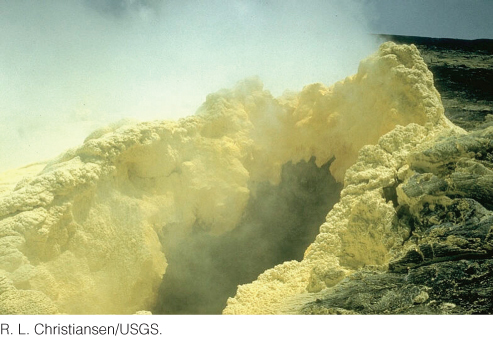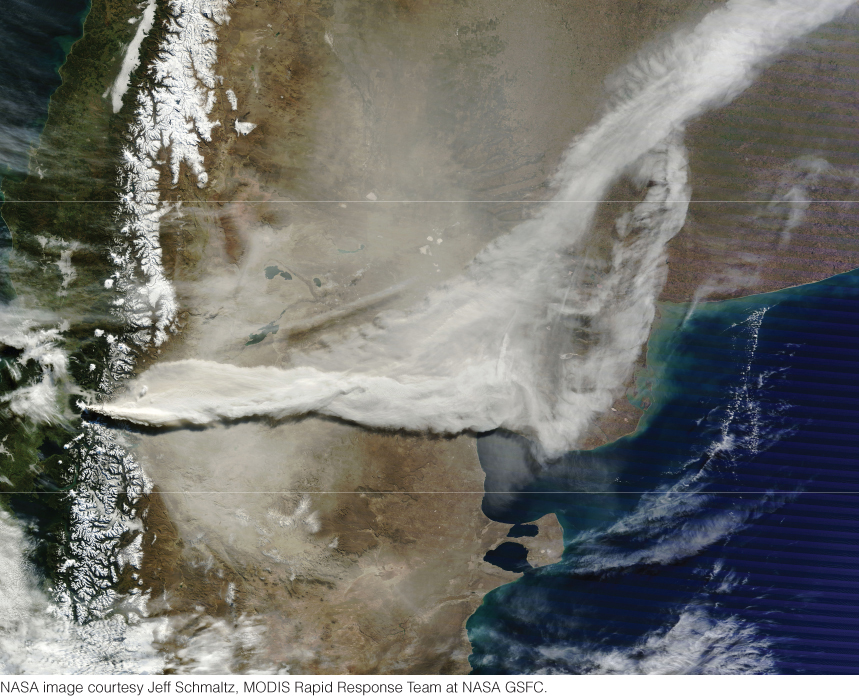Interactions of Volcanoes with Other Geosystems
Volcanoes are chemical factories that produce gases as well as solid materials. Courageous volcanologists have collected volcanic gases during eruptions and analyzed them to determine their composition. Water vapor is the main constituent of volcanic gases (70 to 95 percent), followed by carbon dioxide, sulfur dioxide, and traces of nitrogen, hydrogen, carbon monoxide, sulfur, and chlorine. Volcanic eruptions can release enormous amounts of these gases. Some volcanic gases may come from deep within Earth, making their way to the surface for the first time. Some may be recycled groundwater and ocean water, recycled atmospheric gases, or gases that were trapped in earlier generations of rocks.
327
As we have seen, volcanic gases released at Earth’s surface have a number of effects on other geosystems. The emission of volcanic gases during Earth’s early history is thought to have created the oceans and the atmosphere, and volcanic gas emissions continue to influence those components of the Earth system today. Periods of intense volcanic activity have affected Earth’s climate repeatedly, and they may have been responsible for some of the mass extinctions documented in the geologic record.
Volcanism and the Hydrosphere
Volcanic activity does not stop when lava or pyroclastic materials cease to flow. For decades or even centuries after a major eruption, volcanoes continue to emit steam and other gases through small vents called fumaroles (Figure 12.20). These emanations contain dissolved materials that precipitate onto surrounding surfaces as the water evaporates or cools, forming various encrusting deposits. Some of these precipitates contain valuable minerals.

Fumaroles are a surface manifestation of hydrothermal activity: the circulation of water through hot volcanic rocks and magmas. Circulating groundwater that comes into contact with buried magma (which may remain hot for hundreds of thousands of years) is heated and returned to the surface as hot springs and geysers. A geyser is a hot-water fountain that spouts intermittently with great force, frequently accompanied by a thunderous roar. The best-known geyser in the United States is Old Faithful in Yellowstone National Park, which erupts about every 90 minutes, sending a jet of hot water as high as 60 m into the air (Figure 12.21). We’ll take a closer look at the mechanisms that drive hot springs and geysers in Chapter 17.

Hydrothermal activity is especially intense in the spreading centers at mid-ocean ridges, where huge volumes of water and magma come into contact. Fissures created by tensional forces allow seawater to circulate throughout the newly formed oceanic crust. Heat from the hot volcanic rocks and deeper magmas drives a vigorous convection current that pulls cold seawater into the crust, heats it, and expels the hot water back into the overlying ocean through vents on the rift valley floor (Figure 12.22).

Given the common occurrence of hot springs and geysers in volcanic geosystems on land, the evidence for pervasive hydrothermal activity at spreading centers immersed in deep water should come as no surprise. Nevertheless, geologists were amazed once they recognized the intensity of the convection and discovered some of its chemical and biological consequences. The most spectacular manifestations of this process were first found in the eastern Pacific Ocean in 1977. Plumes of hot, mineral-laden water with temperatures as high as 350°C were seen spouting through hydrothermal vents at the crest of the East Pacific Rise (see Figure 11.15). The rates of fluid flow turned out to be very high. Marine geologists have estimated that the entire volume of the ocean’s water is circulated through the cracks and vents of Earth’s spreading centers in only 10 million years.
328
Scientists have come to realize that the interactions between the lithosphere and the hydrosphere at spreading centers profoundly affect the geology, chemistry, and biology of the oceans in a number of ways:
 The creation of new lithosphere accounts for almost 60 percent of the energy flowing out of Earth’s interior. Circulating seawater cools the new lithosphere very efficiently and therefore plays a major role in the outward transport of Earth’s internal heat.
The creation of new lithosphere accounts for almost 60 percent of the energy flowing out of Earth’s interior. Circulating seawater cools the new lithosphere very efficiently and therefore plays a major role in the outward transport of Earth’s internal heat. Hydrothermal activity leaches metals and other elements from the new crust, injecting them into the oceans. These elements contribute as much to seawater chemistry as the mineral components dumped into the oceans by all the world’s rivers.
Hydrothermal activity leaches metals and other elements from the new crust, injecting them into the oceans. These elements contribute as much to seawater chemistry as the mineral components dumped into the oceans by all the world’s rivers. Metal-rich minerals precipitate out of the circulating seawater and form ores of zinc, copper, and iron in shallow parts of the oceanic crust. These ores form when seawater sinks through porous volcanic rocks, is heated, and leaches these elements from the new crust. When the heated seawater, enriched with dissolved minerals, rises and reenters the cold ocean, the ore-forming minerals precipitate.
Metal-rich minerals precipitate out of the circulating seawater and form ores of zinc, copper, and iron in shallow parts of the oceanic crust. These ores form when seawater sinks through porous volcanic rocks, is heated, and leaches these elements from the new crust. When the heated seawater, enriched with dissolved minerals, rises and reenters the cold ocean, the ore-forming minerals precipitate.
The energy and nutrients at hydrothermal vents feed unusual colonies of strange organisms whose energy comes from Earth’s interior rather than from sunlight (see Figure 11.15). Chemoautotrophic hyperthermophiles, similar to those that populate hot springs on land, form the base of complex ecosystems, providing food for giant clams and tube worms up to several meters long. Some scientists have speculated that life on Earth may have begun in the energetic, chemically rich environments of hydrothermal vents (see Chapter 11).
Volcanism and the Atmosphere
Volcanism in the lithosphere affects weather and climate by changing the composition and properties of the atmosphere. Large eruptions can inject sulfurous gases into the atmosphere tens of kilometers above Earth (Figure 12.23). Through various chemical reactions, these gases form an aerosol (a fine airborne mist) containing tens of millions of metric tons of sulfuric acid. Such aerosols may block enough of the Sun’s radiation from reaching Earth’s surface to lower global temperatures for a year or two. The eruption of Mount Pinatubo, one of the largest explosive eruptions of the twentieth century, led to a global cooling of at least 0.5°C in 1992. (Chlorine emissions from Mount Pinatubo also hastened the loss of ozone in the atmosphere, nature’s shield that protects the biosphere from the Sun’s ultraviolet radiation.)

329
The debris lofted into the atmosphere during the 1815 eruption of Mount Tambora in Indonesia resulted in even greater cooling. The next year, the Northern Hemisphere suffered a very cold summer; according to a diarist in Vermont, “no month passed without a frost, nor one without a snow.” The drop in temperature and the ash fall caused widespread crop failures. More than 90,000 people perished in that “year without a summer,” which inspired Lord Byron’s gloomy poem, “Darkness”:
I had a dream, which was not all a dream.
The bright sun was extinguish’d, and the stars
Did wander darkling in the eternal space,
Rayless, and pathless, and the icy earth
Swung blind and blackening in the moonless air;
Morn came and went—and came, and brought no day.
And men forgot their passions in the dread
Of this their desolation; and all hearts
Were chill’d into a selfish prayer for light.